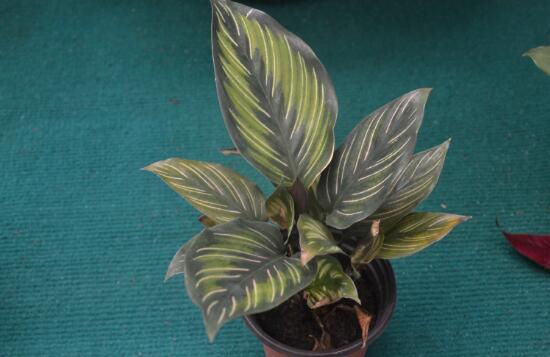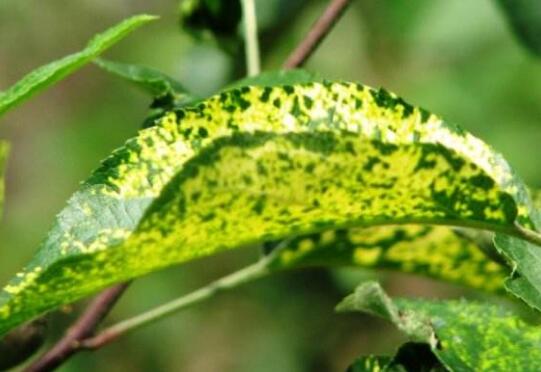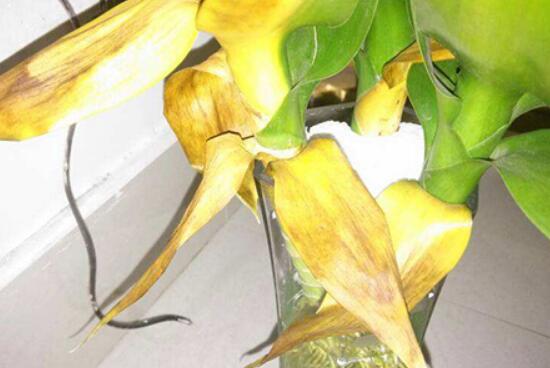How to do the yellow leaves of double-line arrowroot, suitable for light/reasonable water and fertilizer/pest spray
As a common foliage plant, the leaves of double-line taro are rich in color, which are equal to white, green and red, giving people a unique visual enjoyment. But in the process of breeding, because of some reasons, its leaves will be yellow, thus affecting the overall ornamental, then double-line taro leaves yellow how to do? Today, the editor is here to solve this problem for everyone.
First, what if the leaves of the double-line taro turn yellow?

When it comes to the yellowing of double-line taro leaves, in addition to environmental discomfort, it is caused by improper maintenance: when the light is insufficient or too strong, add light or shade; water and fertilizer is inappropriate, reasonable watering and fertilization, if there are rotten roots, you should also take off the pot and cut the roots, and then change the pot soil to plant again; if it is caused by diseases and insect pests, spray in time for prevention and control.
Second, the causes and remedial measures of yellowing of double-line taro leaves.
1. Environmental mutation
As for the reason for the yellowing of double-line taro leaves, if it is a new potted plant, it may be caused by a sudden change in the environment. Because many of the flower friends' double-line taro potted plants are purchased online, it is easy to cause a big change in the environment, and the double-line taro can not adapt for a while, resulting in leaf yellow symptoms.
Remedy: according to the growth habits of double-line taro, we should create an optimal growth environment for the newly bought potted plants. after a period of time, the plant will return to health.
2. Improper lighting
Lack of light: although double-line taro is shady, it also has a demand for light. once it is in a shady environment for a long time, its leaves will turn yellow because they do not get enough sunlight to form chlorophyll. Remedy: supplement the light, but be careful that the light is not too strong.
The light is too strong: double-line taro avoid strong light, once the strong sun shines directly on its leaves, it is easy to cause flower leaf tip, leaf edge withered, leaf sunrise part of the macula. Remedy: move the flowerpot to the shade in time, wait for it to slow down, then water it properly, and then gradually move to a place with good light.
3. Improper watering
Too little watering: double-line taro likes the humid environment, daily maintenance needs frequent watering to keep the basin soil moist. Once the water is underwatered, the leaves will turn yellow because of lack of water, which shows that the old leaves wither and fall off from the bottom up, but the new leaves grow normally. Remedy: appropriate amount of watering, sufficient watering and thorough watering.
Overwatering: double-line taro likes water, but there is also a degree if it is watered too much, resulting in stagnant water in the basin, the root system will have difficulty breathing, resulting in symptoms of yellowing of double-line taro leaves. Remedy: put the double-line taro in a ventilated and cool place, let the moisture evaporate quickly, and those with rotten roots need to be cut off, and then put back into the basin.
4. Excessive fertilization
Insufficient fertilization: the leaves of double-line taro are broad and rich in color. If you want it to grow well, it is very important to apply the right amount of fertilizer. In the process of breeding, if there is not enough fertilizer, the old leaves will turn yellow because of lack of nutrients. Remedy: replenish nutrients in time, but to double-line taro fertilizer should adhere to thin fertilizer diligently.
Excessive fertilization: although double-line taro likes fertilizer, too much fertilizer will produce fertilizer damage, resulting in dry brown at the tip of the new leaves, and concave and convex not stretched, and the old leaves are scorched yellow and fall off. Remedy: immediately stop fertilizing, and then diluted with water; if the roots are burned, people should also take off the plant, cut off the rotten roots, and then replace them with new potted soil and replant them.
5. Diseases and insect pests
Except for the above points, the yellowing of double-line taro leaves may be caused by diseases and insect pests. It is understood that in the case of improper maintenance and poor environment, double-line taro may be attacked by aphids and shell insects, which mainly harm the leaves of the plant, resulting in yellow leaves.
Remedy: it is simple to identify specific pests and then control them by spraying. As for what kind of medicine should be sprayed, you can refer to the pest control of double-line taro.
Generally speaking, the culture method of double-line taro is not difficult, but because many flower friends are novice, it is inevitable to have the symptom of leaf yellow. However, after reading the full text, I believe you have a bottom in your mind, and the Ye Huang problem can be remedied in accordance with the above methods. With regard to the yellowing of double-line taro leaves, the editor has introduced this, hoping to give you some help.
How to do with the yellow leaves of calendula? how to deal with it?
Calendula leaves yellowing phenomenon, people often think that the disease is causing trouble, in fact, this is only one of the reasons, watering, fertilization, improper lighting will cause yellow leaves. Let's take a look at the reason for the yellowing of calendula leaves.
Analysis on the yellowing of Calendula leaves large pots and small flowers lead to the yellowing of calendula leaves
Some varieties of marigold have larger flower shape, more roots, more water and fertilizer, and small pots can not meet their growth needs. At this time, the old leaves will be dry and yellow, and the tender leaves will be thin. It takes decades to change pots and add 30% rotten soil to the soil to ensure the normal growth of flowers.
Lack of water leads to yellowing of calendula leaves.
Watering reduced, will cause the plant leaves to sag, at this time to immediately spray water to the leaves, and then into the basin watering, watering attention to step by step, do not water too much at one time.
When the weather is dry and the indoor humidity is low, yellow leaves will appear. Especially in the areas where indoor coal fire and heating are used in winter, the disease is more serious. At this time, you should often spray and wash branches and leaves with water close to room temperature to increase air humidity. In summer, water is often sprinkled on the ground, which makes the local environment humid.
Improper fertilization leads to yellowing of calendula leaves.
During the growth period of calendula, long-term non-fertilization or insufficient fertilization will cause the phenomenon of yellow leaves. When fertilizing too much, it is difficult for flowers to absorb excess fertilizer, which will cause root burns and affect the absorption of water and nutrients.
Fertilize once a week in summer, do not fertilize too much. If you fertilize too much, you can water more to dilute the fertilizer in the soil. Lack of fertilizer will lead to soil hardening, should be fertilized immediately, effective within a week, and then fertilized on schedule to make the flowers grow normally.
The cold caused the leaves of calendula to turn yellow.
Calendula leaves the room early and is hit by the cold wind, or the autumn cold does not enter the room in time, causing the flowers to freeze and cause yellow leaves. Therefore, we should do a good job of cold prevention in early spring and late autumn.
Diseases and insect pests lead to the yellowing of calendula leaves
Calendula leaves yellowing phenomenon is often caused by mosaic disease, leaf yellowing will also appear yellow-green mosaic spots, we should pay attention to timely prevention of diseases, timely spraying and give adequate light and ventilation.
Alkali causes the leaves of Calendula to turn yellow.
Due to the long-term watering of potted flowers, saline-alkali is accumulated in the potted soil, and in serious cases, there is an alkaline shell on the potted soil, which makes the flowers and leaves fall off. The method is to change new soil or spray ferrous sulfate solution to the leaves to neutralize, using alum fertilizer water and fermented rice washing water, can achieve better results, but do not apply more, such as ferrous sulfate fertilizing too much, the leaves are also yellow, but do not fall off, at this time should be properly watered alkaline water to adjust.
Air-dried marigold leaves turn yellow
Some flowers cultivated in the north that like the humid environment in the air. Such as camellias, orchids, etc., excessive drying of the air will often lead to leaf tip drying, leaf edge scorching or scorched spots on the leaves. The edges are curled, wrinkled, brown and other symptoms. Especially in the areas where coal fire and heating are used indoors in winter, the disease is more serious. At this time, branches and leaves should be sprayed and washed with water similar to room temperature, so as to increase air humidity. Families growing flowers on the balcony in summer can sprinkle water on the ground of the balcony. Make the local environment moist and have cooling effect.
Unlike our common Compositae plants, it is afraid of hot weather, but it is more resistant to low temperatures, and the environment of minus nine degrees will not be affected. Therefore, to plant this plant, we must first understand its growth habits, and then use reasonable maintenance means.
What if the jasmine leaves turn yellow? Causes and solutions
Jasmine, also known as jasmine, fragrant soul, Molly, Wuli, etc., is an erect or climbing shrub of the genus luteolin. Flowers are famous raw materials for scented tea and important flavor raw materials. Flowers and leaves are used to treat red swelling and pain in the eyes and have the effect of relieving cough and resolving phlegm. But in the actual cultivation, the leaves are often yellowed. Let's take a look at what to do if the jasmine leaves turn yellow.
Partial alkali of basin soil
[reason] Jasmine flowers have been irrigated with alkaline water for a long time, due to the aggravation of alkalinity and lack of iron, resulting in poor plant growth and yellow branches and leaves.
[methods] it can be solved by adding ferrous sulfate liquid or alum fertilizer water and increasing soluble iron in the soil.
Malnutrition
[reason] when jasmine was cultivated in the pot, the soil was not changed and fertilized for a long time, resulting in insufficient nutrients in the soil and yellow leaves.
[methods] the soil should be changed in time and the management of water and fertilizer should be strengthened, and the application of fertilizer and water can also be strengthened directly.
Improper fertilization
[reason] excessive fertilization of jasmine or application of immature organic fertilizer caused "root burning" and withered branches and leaves.
[method] part of the basin soil should be removed and replaced with new basin soil. It is better to apply light fertilizer frequently in peacetime management, and don't want to make it full at once.
Caused by stagnant water
[reason] when the jasmine pot soil is in a moist state for a long time, the roots will suffocate and rot due to lack of oxygen, and the plants will not be able to absorb nutrients and make the leaves yellow and even wither and die.
[methods] watering should be carried out between dry and wet, so that the basin soil should not be always wet.
Temperature discomfort
[reason] Jasmine flowers are not cold-resistant. In case of low temperature, the normal physiological metabolism in the body will be disordered, resulting in yellowing leaves.
[method] the environmental microclimate can be adjusted, plastic film can be added or moved to a place with high temperature for maintenance and management.
Lack of light
[reason] sufficient light conditions are needed during the growth of jasmine flowers, and a good condition can be maintained for a period of time in the semi-shade, but yellow leaves, withered tips, and even fallen leaves will soon appear in the shade places. lack of light generally affects flowering and normal growth.
[methods] adjust the position and increase the lighting time.
Disease and insect damage
[reason] the withered and yellow branches and leaves of jasmine flowers will also occur when they are harmed by red spiders, shell insects and other pests.
[methods] attention should be paid to ventilation, air humidity should be increased for prevention, and timely spraying should be used to prevent and control pests.
- Prev

5 diseases/medicine control effect quickly
In the process of breeding primrose, the last thing we want to encounter is diseases and insect pests. This kind of problem is very harmful to plants, which will not only affect the beauty of plant type, but also lead to plant death when it is serious. So how to prevent and control diseases and insect pests of primrose? The following small series takes everyone to understand
- Next

What is the reason for the yellowing of lotus bamboo leaves? what about the yellowing of lotus bamboo leaves
Lotus bamboo, a beautiful ornamental plant with round stems like bamboo and leaves like lotus flowers, is often potted at home for family greening and decoration. However, in the process of breeding, many flower friends of the lotus bamboo will appear yellow leaves, affecting the ornamental, then what is the reason why the lotus bamboo leaves turn yellow? What if the lotus bamboo leaves turn yellow?
Related
- Fuxing push coffee new agricultural production and marketing class: lack of small-scale processing plants
- Jujube rice field leisure farm deep ploughing Yilan for five years to create a space for organic food and play
- Nongyu Farm-A trial of organic papaya for brave women with advanced technology
- Four points for attention in the prevention and control of diseases and insect pests of edible fungi
- How to add nutrient solution to Edible Fungi
- Is there any good way to control edible fungus mites?
- Open Inoculation Technology of Edible Fungi
- Is there any clever way to use fertilizer for edible fungus in winter?
- What agents are used to kill the pathogens of edible fungi in the mushroom shed?
- Rapid drying of Edible Fungi

